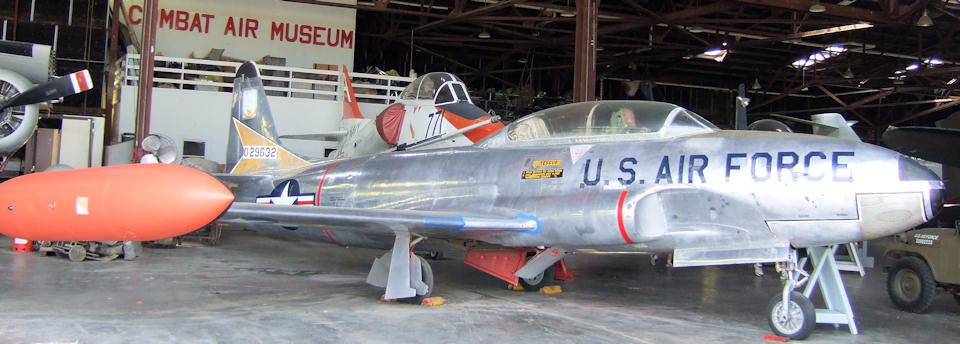There
have been times in aviation history that certain front line combatant
aircraft
were modified into pilot trainers. With most fighter
aircraft this meant changing a single-seat aircraft into a two-seater.
Such was the case with Lockheed’s P-80 (later F-80) Shooting Star,
the first fully operational jet fighter for the United States Air Force
(USAF). In the case of the P-80, its spin-off trainer proved to be such
a success, that it became a production aircraft in its own right and flew
for some 29 years as the T-33.
The
first trainer versions of the P-80 were designated TP-80C and later,
TF-80C. The first TP-80C flew in March 1948. The re-designation to TF-80C
was made in June that year, and after 128 had been produced, a new designation,
T-33A, was given to the type in May 1949. Production of the T-33 reached
5,691 planes in the United States, 656 in Canada, and 210 in Japan. It
remained in production until August 1959 and was flown by the air forces
of over 30 countries. The US Navy and Marine Corps designated the trainer
TO-2, changed to TV-2, and finally T-33B. Many people, in reference to
the T-33, use the nickname “T-Bird.” From 1948, the T-33
remained the only USAF jet trainer until arrival of the Cessna T-37A
in 1957 and the Northrop T-38A in 1961. Over 150 T-33s were still flying
in Air Force and Air National Guard units in 1985, but in 1986 the US
Congress ordered the type removed from US military service by the end
of September 1987.
CAM’s T-33 was manufactured at Lockheed’s
Burbank, California plant and delivered to the Air Force on January
20, 1954. The aircraft
was never assigned to a training command, but spent its career with Air
Defense Command (ADC) units. All ADC units had T-33As assigned for pilot
proficiency flying, and instrument training. After 13 years in the Air
Force, this T-33 was dropped from inventory and later spent some years
in a city park in Viborg, South Dakota.
CAM acquired 52-9632 in 1981. Museum volunteers recovered the aircraft
from Viborg, South Dakota, dismantling and transporting it back to Topeka.
The jet had been heavily vandalized, including holes beaten through the
fuselage. Steel reinforcement bars sat over the cockpit where the canopy
should have been, and the cockpit area was gutted of instruments and
other items.
Once in Topeka, re-assembly
and restoration of the T-33 began. This included a journey by a group
of volunteers to Davis-Monthan
Air
Force Base, (Tucson) Arizona to gather many needed parts and instruments
to bring the T-33 back to display condition. During the restoration,
a number
of parts labeled 1947 were found on the jet, and a credit card, perhaps
lost by one of 632’s former pilots was found in the cockpit.
The trainer carries the markings of the 13th Fighter Interceptor
Squadron, ADC, its last Air Force unit.
This aircraft is on loan from the National Museum of the United States
Air Force Dayton, Ohio.
Assignments |
|
January 1954 |
14th Fighter Interceptor Squadron (FIS), Air Defense Command (ADC), Sioux City, Iowa Municipal Airport. Deployments thereafter to Yuma County Airport, Arizona and Minneapolis/St. Paul Municipal Airport, Minnesota |
July 1957 |
53rd Consolidated Maintenance Squadron, ADC, Sioux City, Iowa |
July 1959 |
13th FIS, ADC, Glasgow Air Force Base (AFB), (north of Glasgow), Montana |
February 1964 |
328th Fighter Wing, ADC, Richards-Gebaur AFB, (Belton) Missouri. |
January 1966 |
13th FIS, ADC, Glasgow AFB, Montana |
February 1967 |
Dropped from Air Force inventory by transfer to school or museum
|
????– July 1981 |
City park in Viborg, South Dakota
|
July 31, 1981 |
Combat Air Museum |
| |
|
TECHNICAL
NOTES: |
(T-33A-1-LO) |
Manufacturer: |
Lockheed Corporation |
Basic Role: |
Tandem, two-place, jet-propelled fighter-trainer. Primary mission
was jet fighter transition
|
Crew: |
Student pilot, instructor pilot
|
Power Plant: |
Allison J33-A-35 centrifugal flow turbojet with 4,600 lbs (2,087kg)
static thrust dry and 5,400
lbs (2,449kg) static thrust with water/alcohol injection
|
Maximum speed: |
599 mph (964km/h)
|
Cruising Speed: |
454 mph (731km/h)
|
Range: Normal: |
1,025 miles (1,650km) Max: 1,270 miles (2,044km)
|
Service ceiling: |
47,500 ft (14,478m)
|
Wingspan: |
38 ft 11 in (11.86m) without tip tanks 43 ft (13.1m) with tip
tanks
|
Length: |
37 ft 8 in (11.49m)
|
Height: |
11 ft 8 in (3.57m)
|
Wing Area: |
235 sq ft (21.83 sq m)
|
Weight: |
Empty: 8,084 lbs (3,667kg) Gross, with full tip tanks: 15,100 lbs (6,849kg)
|
Armament: |
Two .50 caliber machine guns or equivalent ballast in the nose.
|
Serial number: |
USAF 52-9632 |
|







